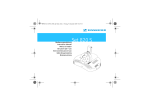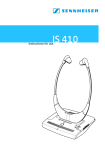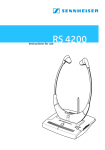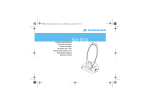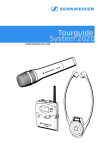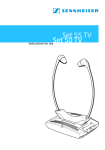Download Sennheiser Set SET 820 Instruction manual
Transcript
Set 820.book Seite 1 Freitag, 9. Dezember 2005 12:36 12 Set 820 Bedienungsanleitung Instruction Manual Notice d´emploi Istruzioni per l´uso Instrucciones para el uso Gebruiksaanwijzing Bruksanvisning Set 820.book Seite 2 Freitag, 9. Dezember 2005 12:36 12 Set 820.book Seite 1 Freitag, 9. Dezember 2005 12:36 12 Deutsch........................................................................................................3 English ...................................................................................................... 23 Français .................................................................................................... 43 Italiano...................................................................................................... 63 Español ..................................................................................................... 83 Nederlands............................................................................................. 103 Svenska .................................................................................................. 123 Set 820.book Seite 2 Freitag, 9. Dezember 2005 12:36 12 Set 820.book Seite 23 Freitag, 9. Dezember 2005 12:36 12 The Set 820 is an assistive listening system for your radio, TV, hi-fi system or similar sound sources at the volume you choose. The transmitter has a range of up to 100 m which allows you to move around freely – without the constrictions of cables. The system uses RF audio signals for sound transmission. 23 English Set 820 Thank you for choosing Sennheiser! Over half a century of accumulated expertise in the design and manufacture of high-quality audio equipment has made Sennheiser a world leader in the field of audiology. Set 820.book Seite 24 Freitag, 9. Dezember 2005 12:36 12 Delivery includes English The Set 820 consists of the following components and accessories: - Stethoset receiver - Transmitter (charging unit) - Rechargeable battery - Power supply - Connecting cable for headphone output - Adapter for SCART socket - Replacement ear pads - Instruction manual 24 RR 820 TR 820 BA 151 NT 820 Set 820.book Seite 25 Freitag, 9. Dezember 2005 12:36 12 Connecting the transmitter (charging unit) English The rear of the transmitter is fitted with two audio inputs: A socket (LINE) for connection to the audio output or the headphone socket on your TV, and a microphone socket (MIC). Plug in one end of the connecting cable to the audio output or the headphone socket on your TV, and the other end to the LINE socket on the transmitter. If your TV set is fitted with a SCART socket, use the supplied adapter. If your TV does not have a headphone or SCART socket, you can use an external microphone which is described in the section “Accessories”. 25 Set 820.book Seite 26 Freitag, 9. Dezember 2005 12:36 12 Only use one of the two audio inputs on the transmitter (MIC or LINE). English Connect the power cable to the POWER socket on the transmitter. Plug the power supply into a household electrical outlet. Pull the power supply unit out of the electrical outlet when the unit will not be used for extended periods of time. Complete freedom of movement It is not necessary that the transmitter and stethoset receiver are in a direct line of sight, so you can move around freely in the home or outside in the garden. One transmitter can be used to transmit to several receivers on the same frequency. The transmitter’s range may decrease due to the surface/composition of walls. 26 Set 820.book Seite 27 Freitag, 9. Dezember 2005 12:36 12 Where to place the transmitter Choose a suitable place near or on top of your hi-fi system or TV set. English Do not place the transmitter close to metal objects such as shelf bars, reinforced concrete walls, etc. The transmitter features a convenient automatic on/off function. The transmitter is turned on by the audio signal. If there is no audio signal for about 3 minutes, the transmitter automatically turns off. The transmitter is now in stand-by mode, its power consumption is very low so that it can remain connected to the mains. Batteries can always be recharged when the transmitter is connected to the mains. 27 Set 820.book Seite 28 Freitag, 9. Dezember 2005 12:36 12 Using the stethoset receiver English When putting the stethoset receiver on, make sure the operating control is pointing downwards and the letters are at the front. The stethoset receiver automatically turns on if you pull the earbows apart. After use, the receiver automatically turns off. 28 Set 820.book Seite 29 Freitag, 9. Dezember 2005 12:36 12 Adjusting the volume Adjust the receiver’s volume with the operating control. English If you are not using the stethoset receiver, store it in the transmitter’s charging compartment so that the battery can be recharged (see section “Charging the battery”). 29 Set 820.book Seite 30 Freitag, 9. Dezember 2005 12:36 12 English Changing the transmission channel To avoid interference caused by the simultaneous operation of several transmitters, select a different channel on each transmitter. Several switchable transmission channels are available (CHANNEL). Due to the required approval two channels are selectable: Positions 1 or 3 = channel 1 Position 2 = channel 2 Turning the automatic compression system on Use the COMP switch (compression) at the rear of the transmitter to turn the automatic compression system on. This system reproduces soft passages louder and decreases loud sounds. Use the MO/ST switch to choose between mono and stereo transmission. For mono TVs and when using the MKE 800 TV microphone, the switch must be set to mono (MO). 30 Set 820.book Seite 31 Freitag, 9. Dezember 2005 12:36 12 Adjusting the receiver channel English First turn on the transmitter (see section “Where to place the transmitter”). Then put on the stethoset receiver - as soon as the receiver is put on it automatically tunes itself to the first strong signal found (normally the transmitter frequency). If, for some reason, the selected channel is not the correct one (e.g. because of interference or another nearby system), press the TUNE button at the rear of the receiver until you can hear the audio signal loud and clear. If you decide to change the transmitter channel, the frequency search tuning must be re-started by pressing the TUNE button on the receiver again (see section “Changing the transmission channel”). 31 Set 820.book Seite 32 Freitag, 9. Dezember 2005 12:36 12 Charging the battery English Place the receiver into the transmitter’s charging compartment, with the operating control at the front. The left LED on the transmitter must light up. Charge the battery for 24 hours before you use it for the first time. The normal charging time is 4-5 hours. A fully charged battery has an operating time of approx. 4 hours. Always store the receiver on the transmitter to ensure that it is fully charged. The transmitter automatically switches to trickle charging so that the battery cannot be overcharged. The receiver can remain in the charging compartment even when the battery has been fully charged. 32 Set 820.book Seite 33 Freitag, 9. Dezember 2005 12:36 12 Additional information Varnish or furniture polish may degrade the rubber feet of the transmitter. Place the transmitter on a nonslip pad to avoid potential staining of furniture. Delivery includes a pair of replacement ear pads. If necessary, remove the old ear pads and slide on the new ones. Use a soft cloth for cleaning the units. Do not use abrasive cleaners. 33 English The audio transmission technology used with this unit is basically that of a radio. According to today’s scientific knowledge, the radio waves emitted by this unit are not harmful to humans or animals. Set 820.book Seite 34 Freitag, 9. Dezember 2005 12:36 12 English WARNING: 34 Volume up? - No! When people use headphones, they tend to choose a higher volume than with loudspeakers. However, if your hearing has deteriorated and you need to rely on an assitive listening system, please avoid listening at high volume levels for a long time. Please protect your hearing. Set 820.book Seite 35 Freitag, 9. Dezember 2005 12:36 12 Accessories ATTENTION: Components from other manufacturers (e.g. for power supply or battery) may cause damage to the unit and will invalidate the warranty. The following accessories are available from your authorized dealer: Rechargeable battery BA 151 Charger L 151-2 Stethoset receiver RR 820 Clip-on receiver with audio socket RR 820 S Transmitter TR 820 External microphone MKE 800 TV 35 English Only use original Sennheiser spare parts and accessories. English Set 820.book Seite 36 Freitag, 9. Dezember 2005 12:36 12 BA 151 rechargeable battery By using a spare battery, you can use the stethoset receiver for more than four hours of continuous operation. Always store the spare battery in the small charging compartment at the right of the transmitter. The right LED on the transmitter lights up green to show charging is taking place. When charging a battery in the small charging compartment, the charging time is 10-12 hours. A battery has a service life of 1-2 years and should be replaced if the operating time decreases. Sennheiser batteries can be recycled. Please dispose of the batteries as special waste or return them to your specialist dealer. To protect the environment, only dispose of totally exhausted batteries which cannot be recharged. L 151-2 charger Spare batteries can be charged via the L 151-2 charger. 36 Set 820.book Seite 37 Freitag, 9. Dezember 2005 12:36 12 RR 820 stethoset receiver One transmitter can transmit to several receivers. Additional RR 820 receivers are available from your authorized dealer. English RR 820 S clip-on receiver Instead of earbows, this receiver features a socket for connecting a headphone or a connecting cable which allows its use with a hearing aid. MKE 800 TV external microphone If your TV doesn’t have a headphone output, SCART or RCA socket, you can use your Set 820 together with the MKE 800 TV microphone. Fix the microphone to the loudspeaker of your TV by means of Velcro tape. Connect the microphone connector to the MIC socket on the transmitter and set the transmitter’s MO/ST switch to mono (MO). 37 Set 820.book Seite 38 Freitag, 9. Dezember 2005 12:36 12 English If problems occur... - Are all jack plugs connected correctly? - Are the receiver and sound source turned on and is the volume of the - receiver and sound source sufficient? - Have you pulled the earbows apart? - Is the battery inserted properly into the receiver? - Have you charged the battery for at least 20 minutes? - Are you too far from the transmitter? (if so, move closer) - Choose a different channel. - Adjust the setting with the TUNE button. - Should the problem persist, please contact your authorized dealer for assistance. Never oper the unit! 38 Set 820.book Seite 39 Freitag, 9. Dezember 2005 12:36 12 Adjusting the earbow pressure Loosen the screw at the rear of the stethoset receiver. Move the screw in the long hole to the desired position (continuously adjustable). 1 = Low earbow pressure 2 = High earbow pressure Tighten the screw. English Additional information for hearing aid acousticians 1 2 Adjustments for hearing disabilities Turn the operating control fully counterclockwise (0). Remove the operating control by carefully lifting it over the "guide notch" on the inside. Use the 4 potentiometers on the circuit board to individually adjust the max. volume and the bass response for the left and right headphone system. Bass response L Bass response R Max. volume L Max. volume R 39 English Set 820.book Seite 40 Freitag, 9. Dezember 2005 12:36 12 Adjusting the max. volume: Potentiometer turned fully counterclockwise Potentiometer turned fully clockwise 0 dB 125 dB Adjusting the bass response: Potentiometer turned fully counterclockwise Potentiometer turned fully clockwise attenuation of -25 dB at 100 Hz attenuation 0 dB The adjustments can also be made when the receiver is being used. When replacing the operating control, make sure the "projections" on the inside of the operating control point in the direction of the earbows. After replacing the operating control, synchronize the operating control with the volume control by once turning it fully counterclockwise and then fully clockwise. 40 Set 820.book Seite 41 Freitag, 9. Dezember 2005 12:36 12 Modulation Carrier frequencies AF frequency response S/N ratio FM, stereo see type plate at the base of the transmitter 40 Hz ....... 15 kHz 60 dB A rms Transmitter RF output power Audio input Microphone socket Charging time for battery Charging time (spare battery) Power supply Weight Dimensions typ. up to 10 mV 3.5 mm jack, stereo/mono 2.5 mm jack, mono approx. 4 h approx. 10-12 h 12 V DC via NT 820 mains unit approx. 94 g (without battery) diameter: 3.8 inch, heigth: 1.1 inch Receiver Max. sound pressure level Power supply Operating time Weight Dimensions > 125 dB 2.4 V via BA 151 battery more than 4 hours per battery approx. 60 g (without battery) length: 9.0 inch, width: 4.9 inch, heigth: 1.0 inch English Technical data 41 Set 820.book Seite 42 Freitag, 9. Dezember 2005 12:36 12 Manufacturer declarations English CE Declaration of Conformity This equipment is in compliance with the essential requirements and other relevant provisions of Directives 1999/5/EC, 89/336/EC or 73/23/EC. The declaration is available on the internet site at www.sennheiser.com. Before putting the device into operation, please observe the respective country-specific regulations! WEEE Declaration Your Sennheiser product was developed and manufactured with highquality materials and components which can be recycled and/or reused. This symbol indicates that electrical and electronic equipment must be disposed of separately from normal waste at the end of its operational lifetime. Please dispose of this product by bringing it to your local collection point or recycling centre for such equipment. This will help to protect the environment in which we all live. Batteries The supplied rechargeable batteries can be recycled. Please dispose of rechargeable batteries as special waste or return them to your specialist dealer. In order to protect the environment, only dispose of exhausted batteries. 42 LetzteSeite_Sp7.fm Seite 3 Freitag, 9. Dezember 2005 12:46 12 LetzteSeite_Sp7.fm Seite 4 Freitag, 9. Dezember 2005 12:46 12 Sennheiser electronic GmbH & Co. KG 30900 Wedemark, Germany Phone +49 (5130) 600 0 Fax +49 (5130) 600 300 www.sennheiser.com Printed in Germany Publ. 01/06 511982/A01


























